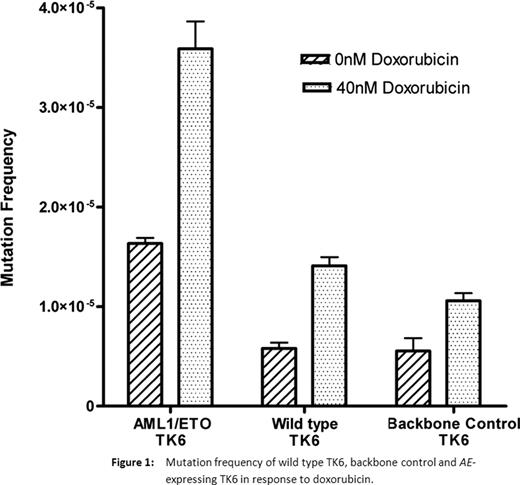Abstract
Abstract 3368
Translocation (8;21)(q22;q22) is the most common cytogenetic abnormality found in acute myeloid leukemia (AML), presenting in around 15% of all cases and is also reported in lymphoid leukemia. This subtype of AML has a favourable prognosis in contrast to other AML subtypes, however the mechanisms underlying this good response to treatment are not well understood. The translocation between AML1 (RUNX1) and the almost full-length ETO (RUNX1T1, MTG8) gene produces a 752 amino acid fusion protein and changes a transcriptional modulator essential for hematopoiesis into a constitutive repressor. When AML1/ETO (AE) is expressed in animal models, further mutations are required for the development of leukemia. AE has also been detected at a considerable frequency in the Guthrie cards of individuals who developed t(8;21) AML up to twelve years later, suggesting that AE+ hematopoietic precursor cells can remain latent for many years before transformation. AE+ cells have an activated p53 pathway, increased levels of p53 response genes and display an increased susceptibility to DNA damaging agents. AE also decreases the levels of DNA repair genes, including those involved in base-excision repair. This evidence predicts the existence of a pre-leukemic, AE-expressing hematopoietic precursor, which easily acquires additional mutations required for transformation, but that also responds well to treatment. There are multiple alternative forms of AE, the best described being AML1/ETO9a (AE9a), which codes for a truncated version of the protein lacking a significant proportion of ETO. AE9a has been found to be more leukemogenic than AE in mouse models by causing leukemia without the need for additional mutations.
Our investigation aims to test the effect of cellular expression of AE or AE9a on mutation, cell death and transformation following exposure to leukemogens and to identify co-operating mutations involved in t(8;21) AML. TK6 lymphoblastoid cells are heterozygous for the TK gene and when exposed to mutagens, can lose their one functional copy and become TK-/-. These mutants can then be selected for and quantified. TK6 were lentivirally transduced with vectors containing EGFP and either AE or AE9a. AE was cloned into the pHR-SINcPPT-SIEW lentiviral transfer vector and a similar AE9a construct acquired. Virus was produced utilising the 293T cell line and TK6 were transduced by a spinfection technique. Expression was confirmed by flow cytometry, western blotting and qRT-PCR. Single clonal populations were generated and fusion gene expression levels of 28% (AE) and 40% (AE9a) relative to AE expression in Kasumi-1 (a t(8;21) AML patient-derived cell line) were achieved.
We used these transduced cell line models to determine whether the presence of AE or AE9a affected cell viability and susceptibility to the acquisition of mutations. Spontaneous TK-/- mutants were first purged from the population by treatment with CHAT media. Two weeks post CHAT treatment, AE+ TK6 were shown to acquire a greater number of mutations than controls, both spontaneously and when exposed to doxorubicin (Figure 1). AE+ TK6 had a 2.2 fold higher background mutation frequency than controls, suggesting that AE promotes spontaneous acquisition of mutations. When treated with low-dose doxorubicin, AE+ TK6 had a 2–3 fold higher mutation frequency (3.5 × 10−5) in comparison to controls; wild-type TK6 and backbone transduced TK6 (1.4 × 10−5 and 1.1 × 10−5 respectively). High density SNP array analysis of AE-expressing TK6 has recently identified deletions at 10q25.1 and 3p24.3. The deletion at 3p24.3 potentially affects expression of SGOL1, coding for a protein involved in sister chromatid segregation and PCAF, an acetyl transferase which has been implicated in the regulation of p53. The effect of the deletion on these genes is currently being evaluated.
Mutation frequency of wild type TK6, backbone control and AE-expressing TK6 in response to doxorubicin.
Mutation frequency of wild type TK6, backbone control and AE-expressing TK6 in response to doxorubicin.
Our data show that TK6 expressing AE or AE9a have an enhanced sensitivity to the cytotoxic effects of the anthracycline doxorubicin. This contributes to the understanding of the relatively good prognosis of t(8;21) AML. We have shown that expression of AE in a cell system promotes the acquisition of more mutations than that of non-expressing cells. This provides further understanding as to how the pre-leukemic AE+ hematopoetic clone transforms and results in leukemia.
No relevant conflicts of interest to declare.
Author notes
Asterisk with author names denotes non-ASH members.


